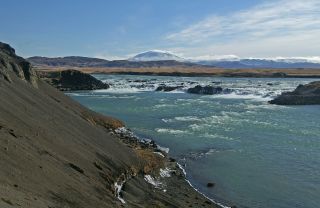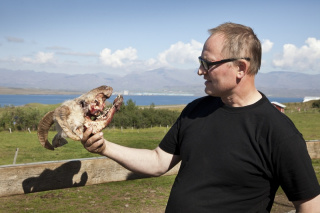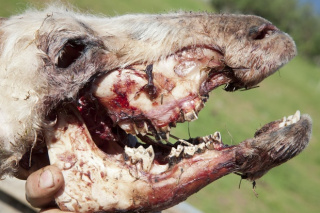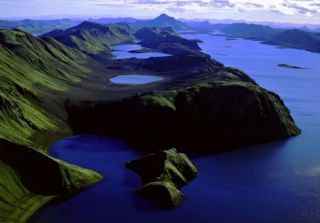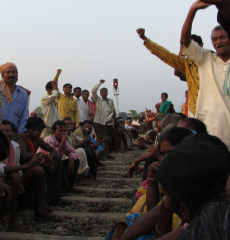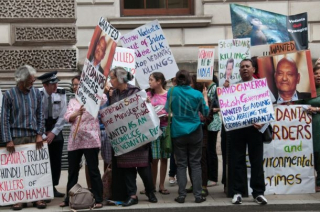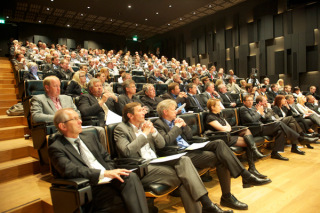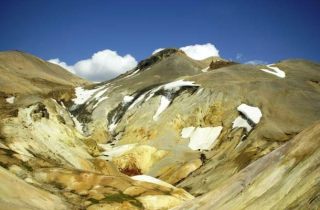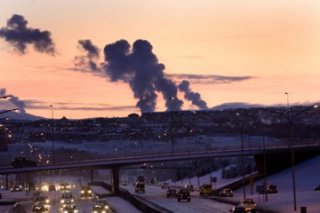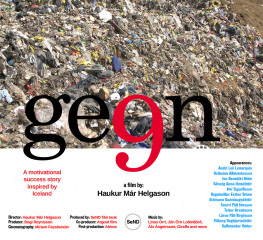News
Aug 27 2011
Ecology, Landsvirkjun, Þjórsá
Originally published by Reykjavík Grapevine
A plan to build three dams in the river Þjórsá could wipe out salmon in the river. National power company Landsvirkjun insist they have measures on the table to keep the salmon alive. Vísir reports that an environmental assessment has already confirmed that should the three proposed dams be built, the salmon that use the river will disappear.
Plans to dam Þjórsá have not been without their controversy, as the project has been heatedly debated for years now. In fact, the notion that damming up the river would wipe out salmon from the river was known as far back as 2002. While Landsvirkjun says they would construct what effectively amounts to a sperm bank for salmon to fertilise eggs, the Ministry for the Environment has looked at the plan and concluded that nothing in the plan indicates that it would even work.
The three dams have been green-lit, though, so the options now on the table are to either find some other way to save the river’s salmon while construction goes underway, or to pull the plug on construction, either temporarily or permanently. Neither option will be inexpensive for the parties involved.
Report by Dr. Ranghildur Sigurðardóttir on the effects of a dam at Urriðafoss in Þjórsá. (in Icelandic)
Aug 18 2011
Actions, Cairn Energy, Corruption, India, Mining, Repression, Sri Lanka, Vedanta
At 2.30pm today 10 people arrived unannounced at the offices of Cairn Energy at the Clydesdale Plaza in central Edinburgh. They installed themselves at the grand entrance to the building, blowing whistles and shouting: “No oil for Vedanta! Stop, stop, stop the deal!” and “Vedanta out of Sri Lanka”, attracting the attention of the floods of passers-by attending the Edinburgh theatre festival. Three of the demonstrators gave out leaflets in the street from the campaign group Foil Vedanta and explained that the demonstration was timed with Cairn India’s AGM in Mumbai, where the Vedanta-Cairn deal would be discussed. The leaflets describe the protest as in solidarity with Indian people’s movements in communities affected by Vedanta’s atrocities including Niyamgiri and Puri in Orissa, Advalpal in Goa, and Thoothkudi in Tamil Nadu. They stress Vedanta’s poor environmental track record and demand that the company should not be allowed to take over Cairn India, an oil company drilling in pristine ocean off Sri Lanka.
Protesters claim this is a British issue as both Cairn and Vedanta are British companies, and have been aided by David Cameron and the British Ambassador to India in pushing the deal through. The leaflets highlight Vedanta CEO Anil Agarwal’s position as the 17th richest man in Britain and claim the British government has allowed him to evade millions of pounds worth of tax using Jersey and Bahamas based tax havens. One of the placards showed Cairn CEO Bill Gammell and Vedanta CEO Anil Agarwal in bed with David Cameron and read ‘Bill Gammell, Anil Agarwal, David Cameron in bed for oil’ while another slogan accused all three of having ‘blood on their hands’. A stack of leaflets was handed in to the building to distribute to Cairn Energy staff and a security guard warned those gathered that the police would be called if they remained at the building. This warning was taken seriously in the light of Cairn Energy’s zero tolerance policy on protests at the same offices by Greenpeace a month earlier, at which the company took out injunctions against Greenpeace preventing them from publishing any pictures of the event. The protesters left after an hour.
Below is a press release that followed the protest. Download the leaflet that was distributed at the protest here: Cairn India AGM leaflet. Read More
Aug 15 2011
1 Comment
Century Aluminum, Fluoride, health, Hvalfjörður, Pollution
Grapevine.is
A sheep farmer, noticing bone deformities in the skulls of some sheep, believes they may be connected to an environmental accident at an aluminium smelter in 2006, and is calling for an investigation.
Sigurbjörn Hjaltason, a sheep farmer from Kiðafell, told DV that he had noticed quite a number of sheep in his area having difficulty eating, with some dying of starvation as a result. On examining the skulls of the animals, he discovered unusually large swelling of the jaw bones.
This, he believes, is the result of pollution from an aluminium smelter at nearby Grundartangi. In 2006, an accident at the plant caused fluorine to be released into the environment.
Fluorine, which is also present in volcanic ash, when ingested by animals can cause freakish growths in the bones. Sheep that would eat grass that had been covered in volcanic ash would often times grow unnaturally large teeth that prevented them from being able to eat any food at all, resulting in starvation.
The conclusion of the Environmental Office at the time of the accident was the fluorine levels in the surrounding area had doubled.
Sigurbjörn has called for a full investigation, and wants an independent team of scientists to examine the teeth and bones of the sheep that have died.
See also:
More Flouride in Animals Around Aluminium Factories than Elsewhere – Environmental Agency Refuses to Investigate
Pollution from Smelters Damages Teeth in Sheep
Jul 31 2011
Energy Master Plan, Kárahnjúkar, Landsvirkjun, Langisjór, Rio Tinto Alcan, Tungnaá, Þjórsá
After many years of planning to change lake Langisjór, located at the western edge of Vatnajökull, into a reservoir for energy production, Landsvirkjun’s fantasies have finally been permanently ceased. Last Friday, July 29th, Iceland’s Ministry of Environment announced the publication of a regulation to validate the enlargement of Vatnajökull national park, which includes the protection of Langisjór and partly the volcanic canyon Eldgjá and its surroundings. The regulation is the final step in an agreement, signed in February this year, between the Ministry of Environment and local authority of Skaftá district concerning the enlaregment of the national park, based on the priceless value of the area’s natural features. This manifests the full realization of one of Iceland’s environmental movement’s biggest victories.
Landsvirkjun, Iceland’s national energy company, intended to channel river Skaftá to river Tungnaá river through Langisjór, which would effectively become a reservoir. The Skaftá dam (Skaftárveita) would have added another 7 km2 to the lake-reservoir with the purpose of increasing the energy capacity of planned dams in rivers Þjórsá and Tungnaá. The three planned dams in Þjórsá have been met with fierce local and national opposition whereas the construction of Búðarháls dam in Tungná is already taking place, its energy meant for increased aluminium production in Rio Tinto’s Alcan smelter in Straumsvík. Effectively, the damming of Langisjór would lead to a sediment build-up and increased turbidity which would destroy the lake ecosystem. Read More
Jul 21 2011
India, Mining, Vedanta
The Saving Iceland collective is happy to point its readers to the
newly established website of Foil Vedanta, an independent campaigning organization focused primarily on the British-Indian mining giant Vedanta Resources PLC. Explaining the campaign, Foil Vedanta, says on its website that “ Vedanta is headed by Britain’s seventeenth richest billionaire, Anil Agarwal, and was launched on the London Stock Exchange in 2006 with the assistance of the UK’s Department for International Development and Department of Trade and Industry, who continue with their support. Vedanta is a major producer of aluminum, a strategically important metal for the UK’s huge arms industry.” And continues:
Vedanta has mines, refineries and factories in various states in India – including Orissa, Chhattisgarh and Goa – as well as in Zambia. In Orissa Vedanta hopes to mine the mineral-rich Niyamgiri mountain. This would destroy the lives and livelihoods of the Adivasi (aboriginal) Dongria Kond people who live in the region. Despite the Indian Ministry of Environment repealing permission to mine Niyamgiri in 2010, Vedanta continues to push for the project, which if successful would be an act of cultural genocide. Read More
Jul 11 2011
2 Comments
Actions, Cairn Energy, Corruption, Greenland, India, Mining, Orissa, Vedanta
Call for protest at the Vedanta AGM (Annual General Meeting) 2011, 3pm on 27th July, Queen Elizabeth II conference centre, London, SW1P 3EE.
Please join us for the 7th annual protest outside the AGM of Vedanta Resources, the now infamous UK registered Indian mining company who have this year been exposed by the Indian government for serial environmental and human rights violations. We stand in solidarity with the Dongria Kondh and other inhabitants of Niyamgiri and Lanjigargh who have lost land, health and livelihood to Vedanta’s refinery, and faced repression and struggle in fighting Vedanta’s plans for a 73 million tonne bauxite mine and a six fold increase in the refinery’s capacity. We oppose Vedanta’s attempted take-over of British Oil company Cairn Energy who plan to drill in Greenland and Sri Lanka.
In 2010, protests outside Vedanta’s AGM made headlines as protesters on the outside shouted slogans targeting CEO ad majority shareholder Anil Agarwal for the ‘blood on his hands’, as well as David Cameron who was in India promoting joint UK-Indian business ventures at the time. Meanwhile activist shareholders held Vedanta to account inside the AGM, and key investors Aviva threatened to pull out due to the company’s ‘disdain’ for OECD environmental law. One month later the Indian government’s Saxena Report damned Vedanta for violations of tribal rights and environmental law at the Niyamgiri hills. Vedanta is also being investigated by the Indian government’s Lok Pal anti-corruption ombudsman for massive corruption over the illegal acquisition of 3000 acres of land for a ‘Vedanta University’ in Puri, Orissa. Read More
Jun 29 2011
2 Comments
ALCOA, Alterra Power/Magma Energy, Century Aluminum, Corruption, Economic Collapse, Geothermal Cluster, Geothermal Energy, Greenwash, H.S. Orka, Helguvík, Landsvirkjun, Media bias, Reykjavik Energy
Dozens of Icelandic companies and institutions, all directly connected to the heavy industrialization of Iceland, have established a co-operating forum concerning the development of the so-called “Icelandic geothermal cluster”. The forum, which was formally established yesterday, June 28th, is originally a conception by Dr. Michael Porter, professor at Harvard Business School and known as “a leading authority on company strategy and the competitiveness of nations and regions.” Interviewed by a news-report TV show Kastljós, Porter, who was in Iceland to take part in the forum’s formal establishment, said that Icelanders are “too cautious” when it comes to “using the opportunities that consist in geothermal energy and the nation’s expertise on the issue.” Contrary to Porter, environmentalists and
Iceland’s National Energy Authority fear the overexploitation of geothermal resources. Read More
Jun 24 2011
4 Comments
Corruption, Dams, Democracy deficit, Energy Master Plan, Geothermal Energy, Government, hydropower, Jökulsá á Fjöllum, Landsvirkjun, Langisjór, Skagafjörður, Þjórsá, Þjórsárver
At the beginning of July the results of a framework programme, concerning the exploitation and protection of Iceland’s natural resources, will be presented publicly. The timing of the presentation has much more to do with demands from the labour market agents, rather than the government’s will to try to reach a settlement about the result, according to the Icelandic Nature Conservation Association (INCA, or NSÍ in Icelandic), which is highly critical of many aspects of the making of the framework programme.
One of the association’s primary criticisms is directed towards the fact that a particular committee, nominated to sort the areas in question into three different categories: protection, hold and utilization – did not include a single representative from environmentalist organizations. Whereas representatives from the energy and tourism industries, as well as the ministries of environment and industry, had seats on the committee. The viewpoint of nature conservation has thus no spokesperson in the working progress, states a press release from INCA. Read More
Jun 10 2011
1 Comment
ALCOA, Century Aluminum, Geothermal Energy, Greenwash, Helguvík, Hengill, HRV/Hönnun, Kárahnjúkar, Pollution, Reykjavik Energy, Rio Tinto Alcan
The Public Health Authority of Reykjavík is highly critical of the recently published preliminary Environmental Impact Assessment (EIA) for a 45 MW construction of geothermal power plants at Gráuhnjúkar on Hellisheiði. The reason is that the EIA, carried out by engineering firm Mannvit, hardly mentions the possible effects of the project’s sulphur pollution on the human population living in the capital area of Reykjavík. “They mention the impacts of increased amount of hydrogen sulphide at the power plant area, but hardly mention the capital area where a high proportion of the population lives” said Árný Sigurðardóttir from the Public Health Authority in an interview with newspaper Fréttablaðið. The power plant in Hellisheiði is only about 30 km away from Reykjavík.
Since October 2006 Orkuveita Reykjavíkur (Reykjavík Energy) has produced geothermal energy on Hellisheiði, predominantly for the Norðurál/Century aluminium smelter in Grundartangi, Hvalfjörður. Since then increased sulphur pollution in the power plant’s surrounding area, as well as in the area around Reykjavík, has regularly become a topic of discussion and Sigurðardóttir says that the pollution’s impacts are systematically underestimated. Instead of using recent researches into the issue, Mannvit bases the EIA on prediction-models, but new studies by the University of Reykjavík indicate that the increased use of medicine for asthma and heart disease angina pectoris is directly linked to increased sulphur pollution. Read More
Jun 08 2011
Cultural, Economic Collapse, Ge9n, Repression, RVK9
This weekend a new documentary about the Reykjavík Nine will be premiered in Iceland. The film, called
A9aginst (Ge9n in Icelandic), is directed by author, philosopher and filmmaker Haukur Már Helgason and will be shown at the documentary film festival Skjaldborg, in Patreksfjörður (on the Westfjords), on June 11th. According to the film’s website, “this feature-length documentary is a portrait, or rather nine portraits, of people charged and prosecuted in Iceland for ‘attacking parliament’ in December 2008.”
In a conversation with online newspaper Róstur, the director explained briefly his motivation for making the film:
I make the film… well, I guess because there one catches a glimpse of some potential, some possibility, a will for another kind of society, in the minds of a group of people who the state power has, by charging them, defined as a certain set. The charges basically call for an investigation about who these people, defined as enemies, are, and which thoughts someone somewhere can find so dangerous – because it was clear from the beginning that it was not the “action” in the parliament that was considered so dangerous. Read More
